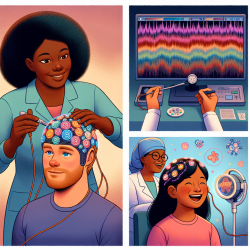Introduction
As professionals in speech-language pathology, we are constantly seeking innovative approaches to improve communication outcomes for individuals with severe communication impairments. A recent study titled "Spelling Interface Using Intracortical Signals in a Completely Locked-In Patient Enabled via Auditory Neurofeedback Training" offers groundbreaking insights into how brain-computer interfaces (BCIs) can facilitate communication in patients with amyotrophic lateral sclerosis (ALS) who are in a completely locked-in state (CLIS).
Understanding the Research
The study explored the potential of using auditory neurofeedback training to enable communication in a patient with ALS who had lost all muscle-based communication abilities. By implanting microelectrode arrays in the motor cortex, researchers were able to record neural signals and provide auditory feedback, allowing the patient to modulate neural firing rates to select letters and form words.
This innovative approach challenges previous assumptions that communication is impossible in CLIS. The findings suggest that with the right technology and training, even individuals in the most severe stages of ALS can regain a form of communication, thereby improving their quality of life.
Implications for Practitioners
For speech-language pathologists and other practitioners, this research underscores the importance of staying informed about technological advancements in communication aids. Here are some key takeaways:
- Embrace Technology: BCIs represent a significant advancement in assistive communication technologies. Practitioners should consider integrating such technologies into their practice, especially for patients with severe motor impairments.
- Focus on Training: The success of neurofeedback training in this study highlights the need for comprehensive training programs for both patients and practitioners. Effective training can enhance the usability and effectiveness of BCIs.
- Advocate for Research: Continued research is essential to refine these technologies and expand their accessibility. Practitioners can play a crucial role in advocating for and participating in research initiatives.
Encouraging Further Research
While this study presents promising results, it also opens the door to numerous questions and potential research avenues. For instance, how can these technologies be adapted for children with communication impairments? What are the long-term effects of using BCIs on neural plasticity and cognitive function?
Practitioners are encouraged to collaborate with researchers to explore these questions and contribute to the growing body of knowledge in this field. By doing so, we can ensure that advancements in technology translate into meaningful improvements in communication outcomes for all individuals, including children.
Conclusion
The study "Spelling Interface Using Intracortical Signals in a Completely Locked-In Patient Enabled via Auditory Neurofeedback Training" provides a powerful example of how innovative technologies can transform communication for individuals with severe impairments. As practitioners, it is our responsibility to leverage these advancements to create better outcomes for our patients.
To read the original research paper, please follow this link: Spelling interface using intracortical signals in a completely locked-in patient enabled via auditory neurofeedback training.










